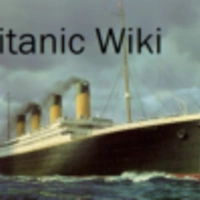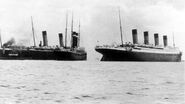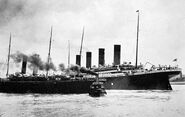The Near-collision in Southampton happened on April 10th, 1912. The SS New York, tied to the RMS Oceanic, drifted off and almost hit the stern of the RMS Titanic. The tugboat Vulcan pulled the New York away.
Olympic-Hawke[]
In 1911, something comparable happened to her sister, but a coming together couldn't be avoided. The HMS Hawke collided with the RMS Olympic. Titanic didn't have as big a speed however and the tugboats had experienced crew onboard that acted quickly which made the difference, and thus a collision was averted.
Titanic-New York[]
At exactly 12:00 P.M, six tugboats pulled the massive Titanic into the river Test, towards the wider water of the river Itchen and into the English Channel, east of the island of Wight. It was way too soon when Captain Smith ordered the first tugs to let go and accelerate Titanic's own engines, increasing speed but also increasing the suction at the stern.
Titanic's speed was already 6 knots when she passed the New York and the Oceanic who were tied together. At that moment, Smith reversed the port propeller to ease the left turn. The suction was way too much for the much smaller New York. With a series of ear-splitting bangs, the six heavy hawsers gave away and she started to drift off to the Titanic. Also the Oceanic started to lean sharply and her gangplank smacked into the water, but most of her hawsers held on.
There was little the crew of the New York could do: their ship had been stranded in Southampton due to a coal strike and it wasn't under steam. However, Captain Gale of the tugboat Vulcan immediately noticed the danger. Titanic's Third Officer Pitman, on the aft bridge, had used a megaphone to get the Vulcan to Titanic's port side to pick up some crew members still on board. This put Gale in a perfect position to offer help. He acted quickly and threw a line to the New York and managed to sufficiently slow down her drift under full steam and lots of smoke from the funnel. Pitman was already calling the bridge, if they knew that another ship was drifting to Titanic quickly. But they already knew it, because at the same moment the port engine restarted and the waves it created slowed the New York down.
Another tugboat assisted the Vulcan and only now the New York was under control. It was only a matter of inches or a collision would have been a fact, and the danger wasn't over at this point. The New York was now pulled between the Oceanic and the Titanic towards the Itchen, with barely any room on either side.
Captain Smith and pilot George Bowyer (who also piloted the Olympic when she hit the Hawke) had matters to think about. Apparently, big ships such as those originating from the Olympic Class needed a different approach from the ones the people were used to, but it was a question as to what kind of approach. Until only a few years earlier, both Smith and Bowyer had only been sailing on ships less than half as big as Titanic, and none of them knew what really happened. Neither did Gale.
- "It's hard to understand what actually happened, but it was a close call.
(...)
I only know that only once opun a hundred times three passenger ships ecape such a dangerous situation without any damage being inflicted."
- Captain Gale, Re-translated from the Dutch translation of the Southampton Times and Hampshire Express, April 11th 1912










